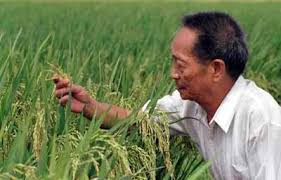Rice is the seed for an ongoing debate in China. One the one hand hybrid rice has better yield. On the other hand some experts say, that hybrid rice is is low quality, does not taste as good, and requires a large amount of fertilizers and pesticides.
Hybrid rice techniques could help feed 70 million more people worldwide every year, according to China’s “father of hybrid rice” Yuan Longping, defying the experts. Pointing to rising populations in Asia, he indicated that quantity should take priority over quality.
Hybrid rice can enhance regular crop yields by about 20 percent, Yuan told the China-Central and Eastern Europe (CCEE) agriculture ministers’ meeting on Saturday in Kunming, Southwest China’s Yunnan Province.
“Rice is the staple food for more than half of the world’s population,” Yuan said, adding that rising populations mean the world will need to produce about 60 percent more rice by 2030 than it did in 1995. Yuan said that a one-hectare rice field can currently sustain 27 people, a number which has to reach 43 by 2050 to meet the world’s food needs.
Today, about 50 percent of China’s total rice fields use Yuan’s hybrid rice species, producing 60 percent of China’s rice. China’s total rice output rose from 5.69 billion tons in 1950 to 19.47 billion tons last year. This annual yield is enough to feed 60 million people, according to the Xinhua News Agency.
“Hybrid rice will play an important role in the new century in terms of food safety and the furtherance of world peace,” Yuan said on Saturday.
The UN’s World Food Program website showed that some 795 million, or about one in nine people globally, do not have enough food to lead a healthy active life.

According to Yuan, more than 4,000 agricultural technicians and officials from over 100 countries have received training from the China National Hybrid Rice R&D Centre in central Hunan Province, and they have popularized the knowledge of hybrid rice planting, as well as research and development technologies.
Experts sow concerns
In spite of developments in hybrid rice techniques and the expansion of hybrid rice’s use globally, though, concerns have been raised by some experts over its quality.
“Increases in crop yield should not come at the expense of a plant’s resistance to diseases, adversity or quality,” Na Zhongyuan, a director with the Yunnan Institute for Ecological Agriculture, told the Global Times.
Na said that Yuan’s hybrid rice needs more chemical fertilizers to maintain its high output, which could have a detrimental effect on the environment. In some regions, planting areas for hybrid rice have shrunk in recent years due to the high costs of seeds, fertilizer and manpower, Na added.
“In spite of its high yield, the low quality of hybrid rice limits its usage because of the relatively high requirements of pesticide and fertilizer,” Li Guoxiang, a researcher at the Rural Development Institute of the Chinese Academy of Social Sciences, told the Global Times on Sunday. Li said some consumers complain that hybrid rice does not taste as good as regular rice and, despite a periodic surplus of rice yields in recent years, the quality of the product remains low.
To advance a more environmentally friendly development, “we should alter our strategies from only pursuing quantity to much better quality,” Li said.
The combination of “high quality” and “high quantity” is very difficult, but not necessarily contradictory, Yuan said at the World Life Science Conference in Beijing last week.
{prepared by Tenzing from media sources}

